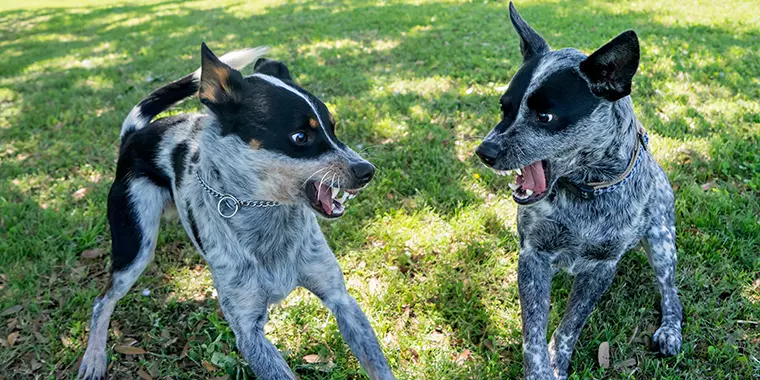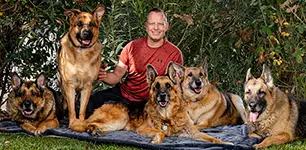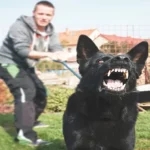
Unfortunately, far too many dog trainers fail to understand the ethological meaning of dominance, submission, and aggression and misuse them. If this topic interests you more, I highly recommend the books by ethologist, Roger Abrantes1 and animal behavior expert Temple Grandin2.
Dominance and submission are terms ethology defines, not dog trainers. To explain these, we have to examine their origin briefly. This starts with a brief look at the dog’s ancestors—wolves.
When wolf puppies grow up, they develop fifteen main behaviors (nine dominance behaviors and six submission behaviors) that will help them negotiate with other wolves during conflicts over resources3 without resorting to a bloody battle. These are essentially escalation (dominant) and de-escalation (submissive) skills to settle disputes. The dominance behaviors develop first, and the submission behaviors develop after, during the maturation of the wolf puppy. This is an important fact that will become clear when we get back to dogs.
The Dominance, Submission, and Aggression Skill Set
The main dominant behaviors are growling, displacing, standing over, inhibited biting, standing erect, body wrestling, aggressive gaping, baring teeth, and staring.
The main submissive behaviors are muzzle licking, looking away, crouching, submissive grinning, passive submission (i.e., the dog lies on its back exposing its anogenital region), and active submission (i.e., the dog approaches in a crouched position, with the tail tucked between the hind legs).
During a conflict, wolves use these escalation and de-escalation skills to negotiate over resources. Wolves negotiate through threats of violence and escalation of force. It will look scary, but none of that is actual aggression or fighting. It’s the attempt to avoid a fight, not start one.
Developmentally Dogs Are Wolf Puppies
This works in the same way with dogs, but dogs don’t go through the entire developmental cycle of a wolf. They stop somewhere in the middle, and how far they mature varies by breed. Developmentally, dogs are wolf puppies. The Siberian Husky is the only dog breed with all fifteen negotiation skills. In contrast, the Cavalier King Charles Spaniel only has two (i.e., growl and displace).
As these skills develop in sequence, dog breeds with nine or fewer skills have essentially no de-escalation skills. This explains the poor social behavior of many dog breeds, especially smaller toy breeds.
Generally, the more a dog breed looks like a wolf, the broader its negotiation skill set will be. If you want to read more about this, I highly recommend the referenced study by Deborah Goodwin3 and Temple Grandin’s book, Animals Make us Human2.
Aggression is a Strategy
People get worried when a dog shows any signs of aggression. That is understandable but often is also an overreaction based on a wrong understanding of aggression. Aggression in nature is useful. Most behaviors are useful in the right context. We wouldn’t object to a German Shepherd Dog herding sheep and rounding them up. However, we would most definitely take issue with the dog doing that to kids on skateboards. The context makes all the difference. A dog biting a home invader is heroic. A dog biting your sister visiting is a problem.
To a predator, aggression is a strategy. This is the same in the human world. If diplomatic efforts fail (negotiation), the next step may be war (aggression) if deemed necessary. Dogs will resort to aggression (aka fighting) after the resource negotiation (dominance and submission displays) fails to reach the desired outcome. However, there is one more thing required for aggression. It must be worth fighting for.
Aggression has a price tag for a predator, so it will only be used when it is truly worth it from their perspective. Fear of harm is one of those ‘good’ reasons to do it. But not many things are. For example, fighting over food may not always be worth it. If food is easy to catch, a predator may give up its catch during a resource negotiation with another dog, even if it is the bigger and stronger animal.
Aggression Has a Price Tag
It can still get injured and weakened in winning that battle, giving an even weaker third party the upper hand to take it afterward. It is a cost/benefit analysis in each scenario. If food is scarce and hard to catch, it may be worth fighting and dying over. If food is abundant, it isn’t.
In nature, mating is one of the things worth dying for. Most other things are not. Aggression is a strategy. Keep that in mind when a dog growls at you. From a dog’s perspective, aggression towards people has no actual cost. People tend to back off and not fight back. Dogs don’t understand that they will later be caught, taken to the vet, and euthanized. They won the battle at the time and got what they wanted.
One of the more special scenarios is food aggression, which is usually a genetic trait and just requires proper management. Food-aggressive dogs are often fantastic dogs in every other aspect. Also, food aggression in nature can be a very useful strategy in the wild, even though it comes at a price, as described above. But, in our homes, the price doesn’t exist from the dog’s point of view. An incorrect assessment but not something a dog can understand.
Conclusion
In summary, a dog’s dominance and submission behaviors are negotiation skills that they use to avoid actual aggression (i.e., fighting). So, that means the term dominance-aggression is flawed because, by the time aggression starts, dominance and submission have failed to avoid a fight.
I want to make one other point. Actual aggression in dogs is rare. Actual aggression is the intent to cause physical harm or death. Dogs with that kind of mindset tend not to live very long. A dog trainer friend of mine likes to say:
If you think you have seen an aggressive dog, you haven’t. Once you see actual aggression, you will never forget or mistake it for something else.
– Chad Mackin
I agree with this statement.
Aggression Is Usually A Strategy
Most of what people refer to as aggression is not that. It is usually an aggressive behavior to accomplish some other goal. In my experience, 9.9 out of 10, aggressive behaviors are rooted in fear and intend to create space and not hurt or kill something. Fearful dogs that show aggressive behaviors don’t know what else to do and do the one thing they know gets everyone to back off.
That doesn’t mean aggressive behaviors are not dangerous. They are extremely dangerous. Nothing is more dangerous than an animal that fears for its safety. But understanding the intent behind the behavior is essential to helping a dog become the best version of itself.
This article is an excerpt from my book “If You Dog Could Talk.”
References
- Roger Abrantes: Author Page of Roger Abrantes at the Ethology Institute
- Temple Grandin: Animals Make Us Human by Temple Grandin, 2009
- Deborah Goodwin: Paedomorphosis Affects Agonistic Visual Signals of Domestic Dogs (PDF) by Deborah Goodwin, John W. S. Bradshaw, and Stephen M. Wickens; Animal Behaviour, 1997, Volume 53, Number 2, Pages 297-304 (Anthrozoology Institute, University of Southampton)
Play the Audio





